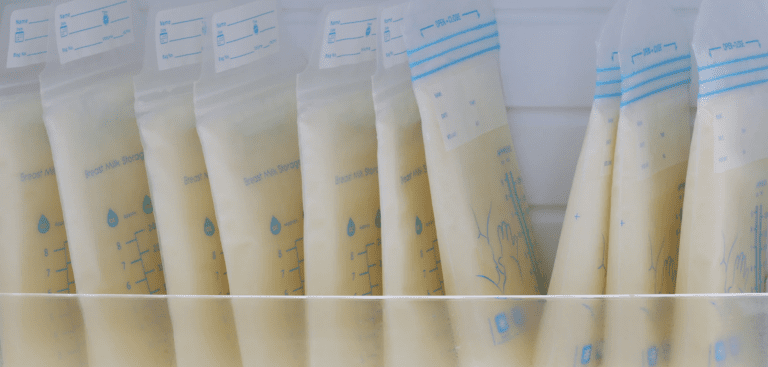5 Common Pumping Mistakes and How to Avoid Them
Pumping can be a lifesaver for breastfeeding moms—providing flexibility, a backup supply, and peace of mind. But let’s face it: pumping isn’t always intuitive, and it’s easy to make mistakes that can lead to frustration, discomfort, or even a dip in milk supply. These 5 common pumping mistakes are something we see time and time again with moms.
The good news? These common pitfalls are completely avoidable with a little knowledge and preparation. Whether you’re an exclusive pumper or just looking to build a freezer stash, these five tips will help you make the most of your pumping routine and avoid the most common mistakes.
Mistake 1: Using the Wrong Pump
Not all pumps are created equal, and choosing the wrong one for your needs can lead to frustration, low milk output, and wasted time.
- Why It Matters: A pump that doesn’t align with your breastfeeding goals or lifestyle can make pumping harder than it needs to be. For example, a hospital-grade pump is ideal for exclusive pumpers, while a wearable pump like the Willow may be better for on-the-go moms.
- How to Avoid It:
- Assess Your Needs: Think about how often you’ll pump and where you’ll use your pump (at home, at work, or on the go).
- Do Your Research: Look for reviews and recommendations on pumps that fit your situation.
- Consult an IBCLC: Lactation consultants can guide you in selecting the best pump for your body and your goals.
Mistake 2: Using the Wrong Flange Size
The flange—the part of the pump that fits over your breast—is often overlooked but plays a huge role in pumping comfort and efficiency. This is the most common pumping mistake we see with our clients.
- Why It Matters:
- A flange that’s too small can cause pain and restrict milk flow, while a flange that’s too large may reduce suction and leave milk behind.
- How to Avoid It:
- Measure Your Nipple Diameter: Use a ruler or nipple measuring tool to find the diameter of your nipple (not the areola) in millimeters. Match this measurement to the pump manufacturer’s flange size guide.
- Reassess Over Time: Your nipple size may change over the course of your breastfeeding journey, so it’s important to reevaluate your flange size periodically.
- Use Inserts: If your size falls between standard flange options, use silicone inserts for a custom fit.
Mistake 3: Inconsistent Pumping Schedule
Pumping sporadically or skipping sessions can confuse your body and reduce your milk supply over time.
- Why It Matters:
- Milk production operates on a supply-and-demand system. Irregular pumping tells your body that less milk is needed, which can lead to a dip in supply.
- How to Avoid It:
- Stick to a Schedule: Aim to pump every 2–3 hours if you’re exclusively pumping or as often as your baby typically feeds.
- Set Reminders: Use alarms or a pumping app to stay consistent, especially during busy days.
- Power Pump if Needed: If you miss a session or notice a drop in supply, try power pumping (10 minutes on, 10 minutes off for an hour) to stimulate milk production.
Mistake 4: Not Replacing Pump Parts
Worn-out pump parts can decrease suction and efficiency, making pumping sessions less productive.
- Why It Matters:
- Over time, parts like membranes, valves, and tubing lose their integrity, which can reduce milk flow and prolong pumping sessions.
- How to Avoid It:
- Know Replacement Guidelines: Check your pump’s manual for recommendations, but as a general rule:
- Replace membranes and valves every 1–3 months.
- Replace tubing every 6 months or if it shows signs of wear.
- Inspect Regularly: Look for cracks, discoloration, or changes in suction.
- Keep Spares on Hand: Stock up on replacement parts so you’re not caught off guard.
- Know Replacement Guidelines: Check your pump’s manual for recommendations, but as a general rule:
Mistake 5: Skipping Hand Expression
Many moms rely solely on the pump to remove milk, but adding hand expression can significantly improve milk output.
- Why It Matters:
- Hand expression helps fully empty the breasts, which can increase supply and prevent clogged ducts or engorgement.
- How to Avoid It:
- Combine Pumping with Hand Expression:
- Before pumping: Gently massage your breasts to stimulate letdown.
- During pumping: Use your hands to compress and massage areas that feel firm.
- After pumping: Spend a few minutes hand-expressing to remove any remaining milk.
- Combine Pumping with Hand Expression:
Bonus Tips for Pumping Success
- Create a Comfortable Setup:
- Choose a space with a supportive chair, a hands-free pumping bra, and essentials like water, snacks, and a phone charger.
- Stay Hydrated and Nourished:
- Your body needs extra fluids and calories to produce milk, so don’t skimp on hydration or nutrition.
- Don’t Compare Output:
- Milk output varies between moms, so focus on what works for you and your baby rather than comparing yourself to others.
What next?
Pumping doesn’t have to be a source of frustration. By avoiding these common mistakes and following simple, effective strategies, you can make pumping more comfortable, productive, and rewarding. Every ounce of milk you pump is a gift for your baby—and a testament to your dedication as a mom.
Want more tips? Browse our other blogs for expert advice and actionable strategies to make your breastfeeding journey easier.
Looking for one on one pumping support? Reach out to our partner IBCLC on demand for insurance covered, personalized care- Click Here to request your visit
FAQ Section
- What type of pump is best for exclusive pumping?
Hospital-grade pumps like the Spectra S1 or Medela Symphony are ideal for exclusive pumpers due to their efficiency and powerful suction. Your insurance will cover the cost of most pumps and will cover rental expenses for more expensive pumps like the Symphony. - How can I tell if my flange size is wrong?
Signs of an incorrect flange size include pain, reduced milk output, and nipple swelling. Measuring your nipple diameter can help you find the right fit. - How often should I pump to maintain supply?
If exclusively pumping, aim for 8–12 sessions daily. If supplementing, pump as often as your baby typically feeds. - What’s the best way to increase milk output while pumping?
Combine hand expression with pumping, ensure your flange fits correctly, and stick to a consistent schedule. Power pumping can also help boost supply. - When should I replace pump parts?
Replace membranes and valves every 1–3 months and tubing every 6 months or sooner if damaged.










